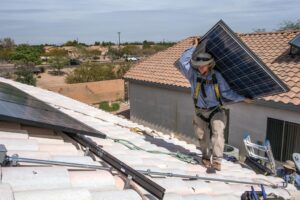Arizona ranks ninth in nation for solar industry growth in 2023, report finds
Arizona was among the top states in the nation for solar industry growth in 2023, according to a trade industry association report released March 6.
The Grand Canyon State ranked No. 9 for photovoltaic solar installations in the U.S. last year, adding 861 megawatts to the electric grid and marking a 25.7% increase over 685 megawatts that came online in 2022, according to the market insight report by the Solar Energy Industries Association and Wood Mackenzie.
Arizona now has a total solar capacity of 6,457 megawatts — enough to power 1.2 million homes — and is projected to have 10,651 megawatts installed by 2028, according to the association. The state had 39,000 solar installations in 2023 for a total of 288,854.
Arizona’s solar growth underscores a breakthrough year for the industry nationwide, which added a record-breaking 32.4 gigawatts of capacity in 2023. Solar accounts for 53% of all new electric generating capacity added to the grid last year, marking the first time in 80 years a renewable energy source has exceeded 50% of annual capacity additions, according to the association.
After installation volumes shrank 9% in 2022 due to trade actions impacting solar imports, the industry “got back to business” last year, buoyed by supply chain stability, the report said.
“If we stay the course with our federal clean energy policies, total solar deployment will quadruple over the next ten years,” Abigail Ross Hopper, president and CEO of SEIA, said in a statement. “The Inflation Reduction Act is supercharging solar deployment and having a material impact on our economy, helping America’s solar module manufacturing base grow 89% in 2023. We must protect and optimize the policies that are driving these investments and creating jobs, and the stakes in the upcoming election couldn’t be higher.”
Texas ranked No. 1 for the greatest number of solar installations in 2023, followed by California, which helped drive national industry growth as customers took advantage of more favorable net metering rules before a switch to net billing in April.
Every solar market segment saw year-over-year growth in 2023, bringing total installed solar capacity in the U.S. to 177 GW. The utility-scale sector alone added 22.5 GW of capacity as new state legislation and the Inflation Reduction Act spurred interest in utility ownership of solar facilities.
What’s more, some 648 utilities nationwide have integrated clean energy goals in their resource planning to meet future electric needs, according to the report.
Arizona Public Service, for example, plans to integrate 3.5 gigawatts of utility-scale solar through 2030, according to the association.
First Solar CEO calls for close on tariff exemptions
While solar module manufacturing capacity grew from 8.5 gigawatts to 16.1 gigawatts in 2023, record low prices for modules and a “tough economic environment” could make it difficult for U.S. manufacturers to follow through on announced facilities, according to the SEIA report.
In 2023, prices for monofacial and bifacial solar modules fell 26% and 31%, respectively. The U.S. currently does not have any ingot, wafer, or cell manufacturing facilities in operation, representing an opportunity for growth, the report said.
Module import volumes increased over 2023 as importers worked with U.S. Customs and Border Protection to ensure compliance with the Uyghur Forced Labor Prevention Act. The temporary moratorium on new anti-circumvention tariffs applicable to certain imports from four Asian countries also brought some stability to the solar supply chain. That moratorium ends in June 2024, according to the report.
In an interview with CNBC Tuesday, First Solar CEO Mark Widmar called for a close on tariff exemptions that allow “cheap components” into the U.S. market.
Some 30 gigawatts to 40 gigawatts of excess product has entered the U.S. market, making it difficult for domestic manufacturers to support a clean energy transition, Widmar said.
“All we want is to be able to compete on our own merits and to the extent there is dumping happening in the U.S. market, it should be addressed,” Widmar told CNBC. “Once it is addressed, we want it to be enforced.”
Tempe-based First Solar (Nasdaq: FSLR) is one of the largest solar panel manufacturers in the U.S., focused on utility-scale projects. It is also one of the largest public companies based in Arizona.
First Solar is “largely insulated” from current market dynamics because the company is booked solid through at least 2026, providing a buffer against market volatility, Widmar said.

